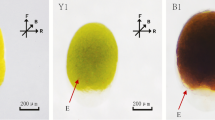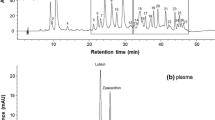Abstract
The phenotypic brownish-green color of an American lobster (Homarus americanus Milne-Edwards, 1837) is determined by genetic and dietary mechanisms. Diet influences color through the carotenoid astaxanthin. This pigment can appear red or blue depending if it is bound to protein, and the relative amounts of each form influence lobster color. Carotenoprotein formation was examined in sibling American lobsters rendered white by a diet low in astaxanthin, by feeding a diet containing 0, 55, 110, or 220 μg astaxanthin g−1 for 110 days beginning on 7 February 2004. The relative levels of red and blue in these lobsters were assessed through the analysis of digital photographs of the lobsters, which were taken monthly. The red/blue ratio was used to assess if free (red) or protein-bound astaxanthin (blue) was the dominant form in the lobsters, or if the two forms occurred in ratios allowing for natural coloration. Naturally colored lobsters developed only in the highest astaxanthin diet group, while lobsters fed the 55-μg diet were blue. Differences were observed among different parts of the body, and were presumed to be a function of cuticle thickness. However, within each diet treatment, some lobsters initially became red, suggesting an accumulation of free astaxanthin, while other lobsters initially became blue, suggesting an accumulation of protein-bound astaxanthin. This variation may be a result of differences in the uptake of astaxanthin, the rate of carotenoid-protein complexing, or in the total amount of protein available for binding. This variability is likely to be the key to understanding the underlying basis of genetically determined color in American lobsters.


Similar content being viewed by others
References
Beal BF, Chapman SR, Irvine C, Bayer RC (1998) Lobster (Homarus americanus) culture in Maine: a community-based, fishermen-sponsored, public stock enhancement program. Can Ind Rep Fish Aquat Sci 244:47–54
Buchwald M, Jencks WP (1968) Properties of the crustacyanins and the yellow lobster shell pigment. Biochemistry 7:844–859
Cianci M, Rizkallah PJ, Olczak A, Raftery J, Chayen NE, Zagalsky PF, Helliwell JR (2002) The molecular basis of the colouration mechanism in lobster shell: β-crustacyanin and 3.2-Å resolution. Proc Natl Acad Sci USA 99:9795–9800
D’Abramo LR, Baum NA, Bordner CE, Conklin DE (1983) Carotenoids as a source of pigmentation in juvenile lobsters fed a purified diet. Can J Fish Aquat Sci 40:699–704
D’Agostino A (1980) Growth and color of juvenile lobsters (Homarus americanus) kept on diets of natural and artificial foodstuff. In: Bayer RC, D’Agostino A (eds) Lobster nutrition workshop proceedings. Maine Sea Grant Publ Tech Rep 58:41–48
Lim BK, Sakurai N, Sugihara T, Kittaka J (1997) Survival and growth of the American lobster Homarus americanus fed formulated feeds. Bull Mar Sci 61:159–163
Mackenthun ML, Tom RD, Moore TA (1979) Lobster shell carotenoprotein organization in situ studies by photoacoustic spectoroscopy. Nature 279:265–266
Nelson K, Hedgecock D (1977) Electrophoretic evidence of multiple paternity in the lobster, Homarus americanus (Milne-Edwards). Am Nat 111:361–365
Salares VR, Young NM, Bernstein HJ, Carey PR (1977) Resonance Raman spectra of lobster shell carotenoproteins and a model astaxanthin aggregate. A possible photobiological function for the yellow pigment. Biochemistry 16:4751–4756
Tlusty MF (2005) The use of digital colour analysis to assess variation within individual adult American lobsters and the process of addition of colour in white lobsters. NZ J Mar Freshw Res (in press)
Young NM, Williams RE (1983) The circular dichroism of ovoverdin and other carotenoproteins from the lobster Homarus americanus. Can J Biochem Cell Biol 61:1018–1024
Acknowledgements
We thank S.DeVito for comments on a previous draft of this manuscript. Numerous volunteers cared for the lobsters, and we thank them all. All lobsters were cared for in accordance with New England Aquarium Animal Care and Use Committee guidelines. This work was partially funded by an equipment grant from the Northeast Massachusetts Aquaculture Center. Comments by two anonymous reviewers greatly improved a draft of this manuscript. The authors declare they have no financial or other compensatory relationship with Aquafauna Bio-Marine.
Author information
Authors and Affiliations
Corresponding author
Additional information
Communicated by J.P. Grassle, New Brunswick
Rights and permissions
About this article
Cite this article
Tlusty, M., Hyland, C. Astaxanthin deposition in the cuticle of juvenile American lobster (Homarus americanus): implications for phenotypic and genotypic coloration. Marine Biology 147, 113–119 (2005). https://doi.org/10.1007/s00227-005-1558-0
Received:
Accepted:
Published:
Issue Date:
DOI: https://doi.org/10.1007/s00227-005-1558-0




